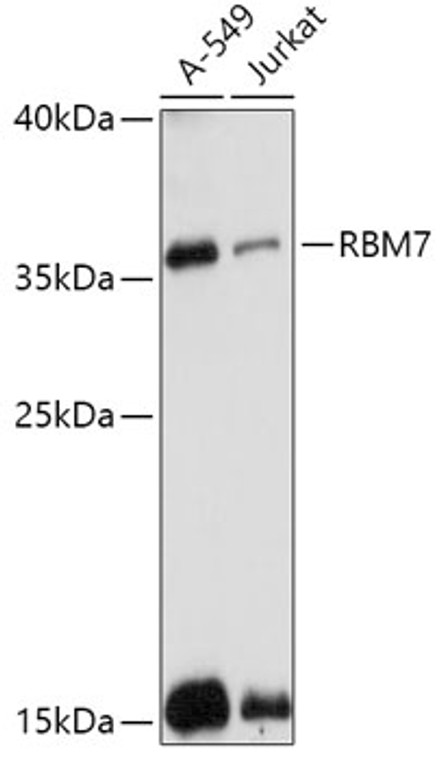| Host: |
Rabbit |
| Applications: |
WB |
| Reactivity: |
Human/Mouse |
| Note: |
STRICTLY FOR FURTHER SCIENTIFIC RESEARCH USE ONLY (RUO). MUST NOT TO BE USED IN DIAGNOSTIC OR THERAPEUTIC APPLICATIONS. |
| Short Description: |
Rabbit polyclonal antibody anti-RBM7 (1-266) is suitable for use in Western Blot research applications. |
| Clonality: |
Polyclonal |
| Conjugation: |
Unconjugated |
| Isotype: |
IgG |
| Formulation: |
PBS with 0.01% Thimerosal, 50% Glycerol, pH7.3. |
| Purification: |
Affinity purification |
| Dilution Range: |
WB 1:500-1:2000 |
| Storage Instruction: |
Store at-20°C for up to 1 year from the date of receipt, and avoid repeat freeze-thaw cycles. |
| Gene Symbol: |
RBM7 |
| Gene ID: |
10179 |
| Uniprot ID: |
RBM7_HUMAN |
| Immunogen Region: |
1-266 |
| Immunogen: |
Recombinant fusion protein containing a sequence corresponding to amino acids 1-266 of human RBM7 (NP_057174.1). |
| Immunogen Sequence: |
MGAAAAEADRTLFVGNLETK VTEELLFELFHQAGPVIKVK IPKDKDGKPKQFAFVNFKHE VSVPYAMNLLNGIKLYGRPI KIQFRSGSSHAPQDVSLSYP QHHVGNSSPTSTSPSRYERT MDNMTSSAQIIQRSFSSPEN FQRQAVMNSALRQMSYGGKF GSSPLDQSGFSPSVQSHSHS FNQSSSSQWRQGTPSSQRKV RMNSYPYLADRHYSREQRYT DHGSDHHYRGKRDDFFYED |
| Tissue Specificity | Ubiquitous. |
| Post Translational Modifications | Phosphorylated at Ser-136 by MAPK14/p38-alpha-activated MAPKAPK2/MK2.this phosphorylation is stress-dependent.this phosphorylation decreases its RNA-binding capacity therefore affecting RNA nuclear exosome-mediated degradation. This phosphorylation mediates YWHAE and YWHAZ interactions. |
| Function | RNA-binding subunit of the trimeric nuclear exosome targeting (NEXT) complex, a complex that functions as an RNA exosome cofactor that directs a subset of non-coding short-lived RNAs for exosomal degradation. NEXT is involved in surveillance and turnover of aberrant transcripts and non-coding RNAs. Binds preferentially polyuridine sequences and associates with newly synthesized RNAs, including pre-mRNAs and short-lived exosome substrates such as promoter upstream transcripts (PROMPTs), enhancer RNAs (eRNAs), and 3'-extended products from small nuclear RNAs (snRNAs). Participates in several biological processes including DNA damage response (DDR) and stress response. During stress response, activation of the p38MAPK-MK2 pathway decreases RBM7-RNA-binding and subsequently the RNA exosome degradation activities, thereby modulating the turnover of non-coding transcriptome. Participates in DNA damage response (DDR), through its interaction with MEPCE and LARP7, the core subunits of 7SK snRNP complex, that release the positive transcription elongation factor b (P-TEFb) complex from the 7SK snRNP. In turn, activation of P-TEFb complex induces the transcription of P-TEFb-dependent DDR genes to promote cell viability. |
| Protein Name | Rna-Binding Protein 7Rna-Binding Motif Protein 7 |
| Database Links | Reactome: R-HSA-72163 |
| Cellular Localisation | NucleusNucleoplasmExcluded From The Nucleolus |
| Alternative Antibody Names | Anti-Rna-Binding Protein 7 antibodyAnti-Rna-Binding Motif Protein 7 antibodyAnti-RBM7 antibody |
Information sourced from Uniprot.org
12 months for antibodies. 6 months for ELISA Kits. Please see website T&Cs for further guidance








